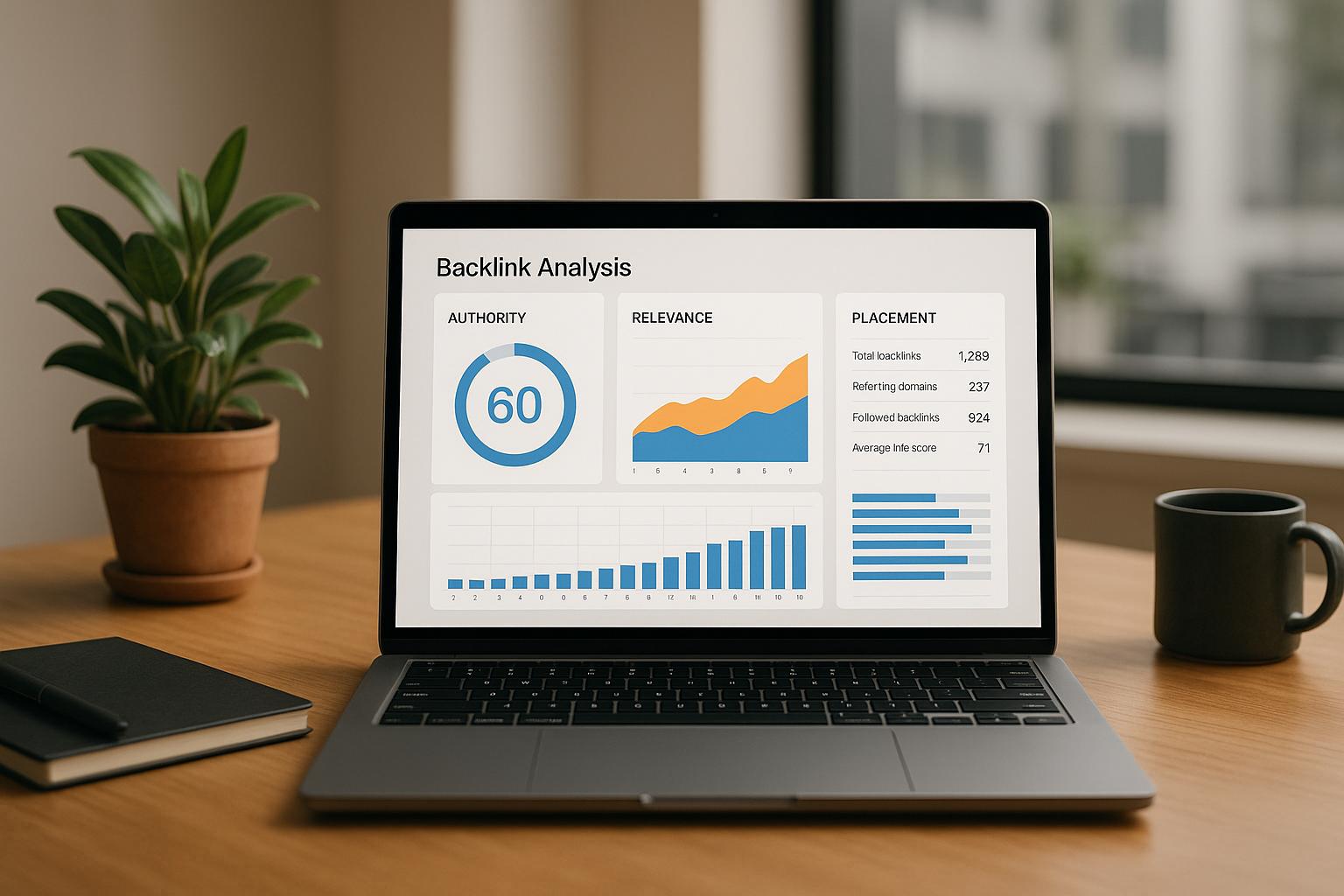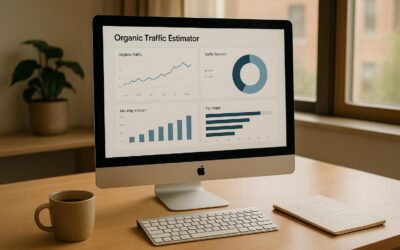Backlinks are still critical for SEO, but not all links are created equal. A quality backlink can boost your rankings, while a bad one can harm them. Here’s what matters most when evaluating backlinks today:
Key Factors for Backlink Quality:
- Relevance: Does the link come from a site related to your content?
- Authority: Is the linking site credible and trusted in its field?
- Placement: Is the link naturally embedded in the main content?
Quick Tips to Assess Backlinks:
- Use tools like Ahrefs or Moz to check Domain Authority (DA).
- Prioritize links from niche-relevant sites over unrelated ones.
- Avoid spammy links from low-quality directories or irrelevant pages.
- Focus on contextual links within body content, not footers or sidebars.
Why It Matters:
- Websites with strong backlink profiles see 67% more organic traffic.
- 94% of content gets zero backlinks, so quality links are a major advantage.
By focusing on relevance, authority, and placement, you can build a backlink strategy that drives real results for your SEO efforts.
How to Evaluate Backlink Quality | Important Benchmarks You Need To Know
Core Metrics for Measuring Backlink Quality
When assessing backlinks, three key metrics serve as reliable indicators of their quality. These metrics help determine whether a backlink will strengthen or weaken your SEO strategy.
Domain Authority
Domain Authority (DA), developed by Moz, is a scoring system that predicts how well a website might rank on search engine results pages (SERPs) compared to others in its niche. Scored on a scale from 1 to 100, DA reflects a site’s ranking potential and changes as search engines and websites evolve over time .
"Domain authority gauges a website’s likelihood of ranking in Google search results based on its overall quality and link profile. While not an official Google ranking factor, it provides valuable insight into how search engines evaluate your site against others." – Kevin Bates, Marketing
Here’s a telling statistic: 90.63% of pages without backlinks receive no organic traffic from Google. This underscores the importance of targeting sites with higher DA scores while also creating content that is engaging, relevant, and valuable. However, DA alone isn’t enough – you also need to consider how relevant the linking site is to your niche.
Relevance
Relevance measures how closely a linking website aligns with your content and industry focus. Backlinks from niche-related sites carry more weight than those from unrelated ones because they signal to search engines that your content fits within a specific topic area. This can lead to better rankings for niche-specific keywords .
Google evaluates relevance by analyzing the context of the linking page, including its keywords and overall content alignment. For instance, a link from a technology blog to your software development article will carry more SEO value than a link from a cooking website.
"If those are the only metrics I can take, I’d take the high-authority, low-relevance link. If, however, the relevant link were lower authority but sent more direct traffic, I’d take that one!" – Rand Fishkin, Moz
This highlights the trade-off between authority and relevance. Depending on your goals, a relevant link with lower authority may still provide greater value, especially if it drives quality traffic. Once relevance is established, the placement of the link becomes the next factor to evaluate.
Link Placement
The placement of a backlink significantly impacts its value. Links embedded within the main body of content carry more weight than those in footers, sidebars, or comment sections. Additionally, links positioned near the beginning of an article tend to have greater influence than those buried toward the end.
Contextual links – those naturally integrated into the content – are more impactful than links placed in peripheral areas. When evaluating link placement, aim for backlinks within the main content and ensure the anchor text is descriptive and relevant.
It’s worth noting that 41% of companies consider backlink building one of the toughest aspects of off-page SEO optimization. By focusing on these core metrics – authority, relevance, and placement – you can build a strategic approach to acquiring high-quality backlinks that genuinely enhance your SEO performance.
How to Assess Backlink Quality: Step-by-Step Guide
Now that you’re familiar with the key metrics, let’s break down how to evaluate your backlinks effectively. This process will help you pinpoint which links are boosting your SEO and which ones might be dragging you down.
Collect and Review Backlink Data
Start by gathering backlink data from multiple sources to get a complete picture of your link profile. A thorough audit not only helps you understand your performance but can also reveal insights about your competitors. Google Search Console is a good starting point, offering free data, but it lacks in-depth link context. For a more detailed analysis, tools like Ahrefs (starting at $99/month) or Moz (also starting at $99/month) can provide additional insights. For instance, Moz’s Spam Score feature is particularly useful for quickly assessing link health.
If your site has been around for a while and accumulated a large number of backlinks, it’s a good idea to combine multiple tools. This approach ensures you capture as many linking root domains as possible. Make sure your chosen tools allow for data import, so you can organize and analyze your findings efficiently.
Check Linking Domain Authority
Once you’ve collected the data, the next step is to evaluate the authority of each linking domain. High-authority sites contribute more to your backlink profile. Tools like MozBar, Semrush, or Ahrefs can help you check metrics such as Domain Authority (DA), Domain Rating, or Authority Score. These numbers often correlate with keyword rankings, making them a reliable measure of link quality.
Compare the domain authority of your backlinks with those of your competitors to see how you stack up. Look for links from sites with authority scores similar to or higher than those in your industry. But don’t stop there – also consider the quality of the backlinks, the relevance of the content, and the engagement levels of the linking site. Make sure the site uses dofollow links (which pass SEO authority) and maintains high editorial standards.
Review Relevance and Context
Relevance is key when it comes to backlinks. Check that the linking site’s overall content aligns with your industry, products, or services. The placement of your backlink should feel natural and make sense within the context of the page. Links that are relevant to the audience of the linking site are generally more valuable.
Once relevance is confirmed, take a closer look at how the link is positioned. A well-placed link not only improves visibility but also enhances its SEO impact.
Check Link Position and Visibility
The location of a backlink on a page can make a big difference. Links embedded within the main content are far more effective than those tucked away in sidebars or footers. Review each linking page to ensure your backlink is naturally integrated into the text. Pay attention to the anchor text – it should be relevant to the linked page and ideally include keywords related to your business. This step will help you identify which links are driving the most value.
Spot and Avoid Spam Signals
A clean backlink profile is essential for maintaining strong SEO performance. Remove links from referring domains that return 404 errors or lack indexed pages, as these offer no value. Watch for unnatural anchor text patterns, such as overuse of exact-match keywords or repetitive phrases. Aim for a diverse anchor text profile that includes a mix of brand names, commercial terms, and natural language.
Be alert for signs of negative SEO or black hat tactics. Sudden spikes in low-quality links or links from suspicious domains can harm your rankings. Common red flags include:
- Low-quality directories with no editorial oversight
- Sites filled with thin or duplicate content
- Pages overloaded with outbound links
- Domains with shady registration details
- Sites in unrelated languages or regions
Tools like Moz’s Spam Score can help you quickly identify and address problematic links that might hurt your SEO.
sbb-itb-880d5b6
Comparing Backlink Quality with Tables
When evaluating backlinks, metrics like authority, relevance, and placement play a crucial role. The tables below break down these factors, offering a side-by-side comparison to help you refine your link-building strategy. By visualizing these differences, you can better focus your efforts on links that will deliver the strongest results.
High-Authority vs. Niche-Relevant Backlinks
A frequent challenge in link building is deciding between backlinks from high-authority domains and those from niche-specific websites. Both types have unique advantages, and understanding their impact can guide your decisions.
| Feature | High-Authority Backlink | Niche-Relevant Backlink |
|---|---|---|
| Domain Authority | High | Moderate to High |
| Relevance | Often lower | High |
| Traffic Potential | High | Targeted |
| Conversion Potential | Lower due to broader audience | Higher due to specific audience match |
| Overall SEO Impact | Strong, broad ranking improvement | Strong, targeted ranking improvement |
This comparison highlights the value of relevance. While backlinks from high-authority sites like major news outlets can strengthen your domain’s overall ranking, niche-relevant links often drive better conversions and attract a more qualified audience.
The ideal scenario? Securing links from sites that combine high authority with niche relevance. These links are harder to obtain but deliver the most impactful SEO benefits. Next, let’s examine how the placement of a backlink influences its effectiveness.
Link Placement Impact Comparison
The location of your backlink on a webpage significantly affects its value. Knowing these differences can help you negotiate for better placements and avoid less effective options.
| Link Placement | SEO Value | Considerations |
|---|---|---|
| Body Content | Most valuable | Contextually relevant and naturally integrated |
| Navigation | Medium | Visible but carries less SEO weight |
| Footer | Least valuable | Often devalued, mainly used for indexing |
SEO expert Rand Fishkin explains:
"Navigation links are more valuable than footer links. But in content, this primary content area right in here, that is where you’re going to get the most link value if you have the option of where you’re going to get an external link from on a page."
The evidence supports this: links within the main content area have the greatest impact, while footer links are often devalued. When pursuing backlinks, prioritize securing placements within the body content for the best results.
Key placement tips:
- Skip sitewide footer links and focus on contextual in-content placements for stronger SEO benefits.
- Target high-impact pages like the homepage, about page, or key product pages.
These insights provide a foundation for refining your strategy, whether through monitoring tools or professional services.
Monitoring Backlinks and Professional Tools
Once you’ve assessed your backlinks, the next step is keeping an eye on them. Backlink monitoring isn’t a one-and-done task – it’s an ongoing process. Links come and go, search engine algorithms shift, and staying proactive is the only way to maintain your SEO momentum. Regular checks ensure your efforts pay off long-term and help you adapt to changes as they happen.
Best Practices for Backlink Monitoring
Keeping tabs on your backlinks can prevent ranking drops and uncover new growth opportunities. The trick is to set up a routine that spots potential issues early and keeps your link profile healthy.
For most websites, checking backlinks weekly works well. However, if your site gets a lot of traffic, daily monitoring might be necessary to quickly catch any harmful backlinks that could hurt your rankings.
Here’s what to focus on:
- Spot and prioritize key links: Pay close attention to backlinks from high-authority domains and dofollow sources since they carry the most weight in boosting your rankings.
- Track new backlinks for indexing: A backlink won’t help your SEO if search engines haven’t indexed it yet.
- Keep an eye on anchor text distribution: A natural-looking anchor text profile is essential to avoid penalties.
- Set up automated alerts: Alerts for new backlinks, lost links, or unlinked brand mentions can help you respond quickly to changes in your link profile.
To ensure accuracy, consider cross-referencing data from multiple tools.
Using Professional Services and Tools
While manual monitoring gives you hands-on insights, integrating professional tools can take your backlink management to the next level. These tools provide the scalability and expertise needed to manage even the most complex link profiles. Whether you go the DIY route or hire professionals depends on your budget, technical know-how, and the size of your backlink portfolio.
Professional tools are designed to scan millions of web pages, helping you identify new, lost, or harmful backlinks. According to recent data, 76.92% of SEO experts prioritize tracking new backlinks, while 72.31% focus on evaluating link quality.
There’s a tool for just about every budget:
- Ubersuggest: A beginner-friendly option starting at $29/month.
- Ahrefs: A more advanced platform starting at $129/month.
Many tools also offer free trials, so you can test their features before committing.
A study by Backlinko founder Brian Dean compared backlink discovery across 107 websites. The results? Semrush outperformed Ahrefs in 93% of cases, identifying a total of 6.93 million backlinks compared to Ahrefs’ 2.43 million. For 65% of the sites tested, Semrush found more than three times as many backlinks as its competitor.
If managing tools yourself feels overwhelming, professional SEO agencies like SearchX offer a hands-off solution. Their link building services focus on acquiring links from authoritative and relevant sources, building a diverse link profile, and using content-driven strategies to attract high-quality editorial backlinks. They also handle continuous monitoring and analysis, ensuring your backlink profile stays strong while uncovering growth opportunities.
This agency approach is especially appealing when you consider that 94% of marketers believe backlinks will remain a cornerstone of Google’s ranking algorithm. For those managing backlinks independently, combining free tools like Google Search Console with paid platforms is a cost-effective way to cover all bases. Google Search Console provides basic backlink data for free, while specialized tools offer deeper insights and competitive analysis.
No matter the approach, consistency is what matters most. Regularly evaluating and documenting your backlink data helps you track progress, identify trends, and fine-tune your future link-building strategies.
Conclusion: Key Points for Backlink Quality Assessment in 2025
Building a solid SEO foundation starts with evaluating backlink quality. The metrics we’ve discussed – like domain authority, relevance, and link placement – work together to give you a clear picture of how strong your backlink profile is. These factors are crucial for keeping your SEO strategy on track and effective.
By following a structured approach, you can spot harmful links, focus on gaining relevant backlinks, and monitor progress. This process not only strengthens your SEO but also provides valuable insights into what your competitors are doing and the quality of your content. Staying proactive in your backlink strategy is key to long-term success.
Using specialized tools to regularly check your backlink profile helps you stay ahead of potential SEO issues. If you find toxic links, document them carefully, remove them, or disavow them using Google Search Console, and keep an eye on the results.
For a more hands-off approach, services like SearchX offer complete SEO solutions. They handle everything from evaluating backlinks to ongoing monitoring, using advanced tools and expertise. This allows you to focus on growing your business while ensuring your backlink profile remains strong. Adopting these practices sets the stage for long-term SEO success.
FAQs
How do I balance domain authority and relevance when choosing backlinks?
To balance domain authority and relevance when choosing backlinks, aim for links from websites that are both highly credible and closely tied to your industry or niche. Domain authority reflects a site’s trust level, while relevance ensures the link adds meaningful context to your content.
Here’s what to keep in mind when assessing backlinks:
- Relevance: Focus on links from websites that directly connect to your industry or appeal to your target audience.
- Authority: Prioritize sites with a strong domain authority to enhance your site’s trust and search rankings.
- Placement: Make sure the links appear naturally within the content, as this improves their overall impact.
By factoring in these elements, you can create a strong backlink profile that boosts your SEO while maintaining both trust and contextual value.
How can I spot spammy backlinks and identify them effectively?
Backlinks can turn into a problem when they come from low-quality or unrelated websites, rely on overly optimized anchor text, or appear in sudden, unnatural bursts. Links from questionable or unsafe sites are also strong red flags for poor-quality backlinks.
To spot these issues, tools like Google Search Console or dedicated backlink analysis platforms can be incredibly helpful. These tools let you assess the relevance, quality, and patterns of your backlinks. By regularly checking your backlink profile, you can quickly identify harmful links and take steps – like disavowing them – to safeguard your SEO efforts.
Why are backlinks placed within the main content more effective than those in footers or sidebars?
Backlinks placed within the main content carry more weight because they are directly tied to the page’s primary information. Search engines tend to see these links as more natural and credible, which can lead to better SEO results.
On the other hand, links found in footers or sidebars are often seen as less relevant since they aren’t part of the core content. As a result, they usually have a smaller influence on search rankings. For stronger SEO impact, focusing on main content placements is the smarter move when building quality backlinks.




